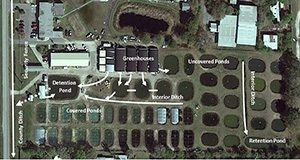Abstract
Understanding how non-native species escape or are accidentally released helps producers better design and operate aquaculture facilities to reduce or prevent escape. Active management of critical points where escape is possible will help achieve regulatory compliance. This 6-page fact sheet is the second in a four-part series devoted to educating industry and other stakeholders on the importance of preventing the escape of non-native species from aquaculture facilities, as well as strategies for non-native species containment and regulatory compliance. It describes farm layouts, explains how fish escape, and outlines a process that aquaculturists can complete to identify potential escape points on their farms. Written by Jeffrey E. Hill, Quenton M. Tuckett, Carlos V. Martinez, Jared L. Ritch, and Katelyn M. Lawson, and published by the School of Forest Resources and Conservation Program in Fisheries and Aquatic Sciences, August 2016.
References
Hill, J. E., and R. P. E. Yanong. 2010. Freshwater ornamental fish commonly cultured in Florida. CIR-54. Gainesville: University of Florida Institute of Food and Agricultural Sciences. http://edis.ifas.ufl.edu/fa054.
Tuckett, Q. M., C. V. Martinez, J. L. Ritch, K. M. Lawson, and J. E. Hill. 2016a. Preventing escape of non-native species from aquaculture facilities in Florida, part 1: general considerations and regulations. FA195. Gainesville: University of Florida Institute of Food and Agricultural Sciences. http://edis.ifas.ufl.edu/fa195.
Tuckett, Q. M., C. V. Martinez, J. L. Ritch, K. M. Lawson, and J. E. Hill. 2016b. Preventing escape of non-native species from aquaculture facilities in Florida, part 3: structural strategies. FA197. Gainesville: University of Florida Institute of Food and Agricultural Sciences. http://edis.ifas.ufl.edu/fa197.
Tuckett, Q. M., C. V. Martinez, J. L. Ritch, K. M. Lawson, and J. E. Hill. 2016c. Preventing escape of non-native species from aquaculture facilities in Florida, part 4: operational strategies. FA198. Gainesville: University of Florida Institute of Food and Agricultural Sciences. http://edis.ifas.ufl.edu/fa198.
Tuckett, Q. M., J. L. Ritch, K. M. Lawson, and J. E. Hill. 2014. Best management practices and escapement of non-native fish from aquaculture facilities in Florida. Final Report. Florida Department of Agriculture and Consumer Services. Tallahassee, Florida.
Tuckett, Q. M., J. L. Ritch, K. M. Lawson, and J. E. Hill. 2016d. "Implementation and Enforcement of Best Management Practices for Florida Ornamental Aquaculture with an Emphasis on Nonnative Species." North American Journal of Aquaculture 78:113-124. https://doi.org/10.1080/15222055.2015.1121176
USFWS. 2015. "Hazard analysis and critical control point (HACCP)." http://www.fws.gov/fisheries/ans/ans-haccp.html
Zajicek, P. W., J. E. Hill, N. Stone, H. Thomforde, C. Ohs, D. Cooper, G. Flimlin, B. Mclane, and W. D. Anderson. 2009. Preventing Hitchhiking Nonindigenous Species in Live Shipments. Southern Regional Aquaculture Center, Stoneville MS, Publication No. 3902.

